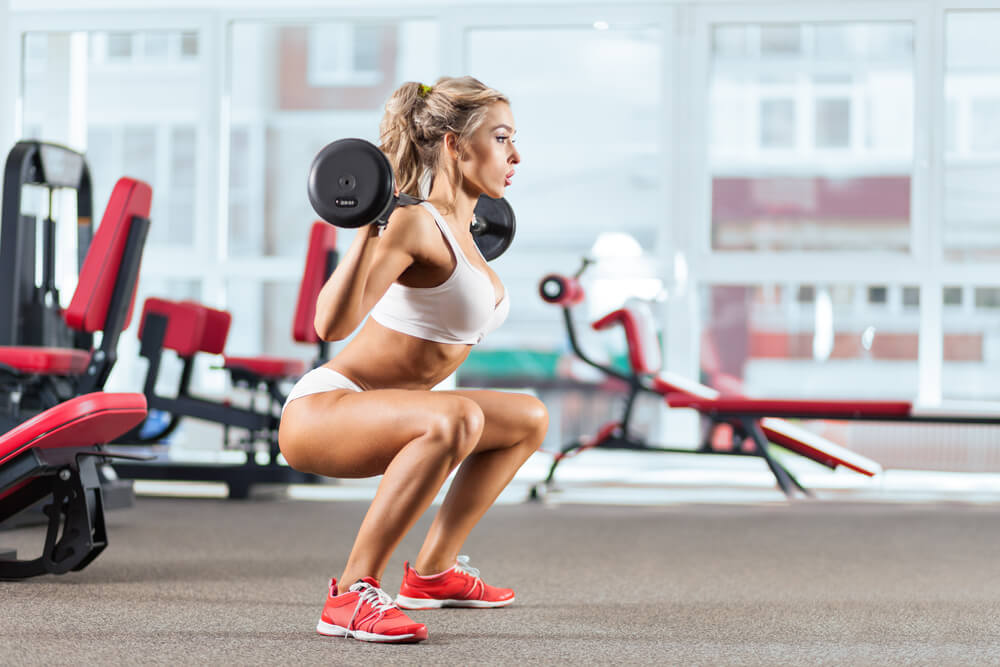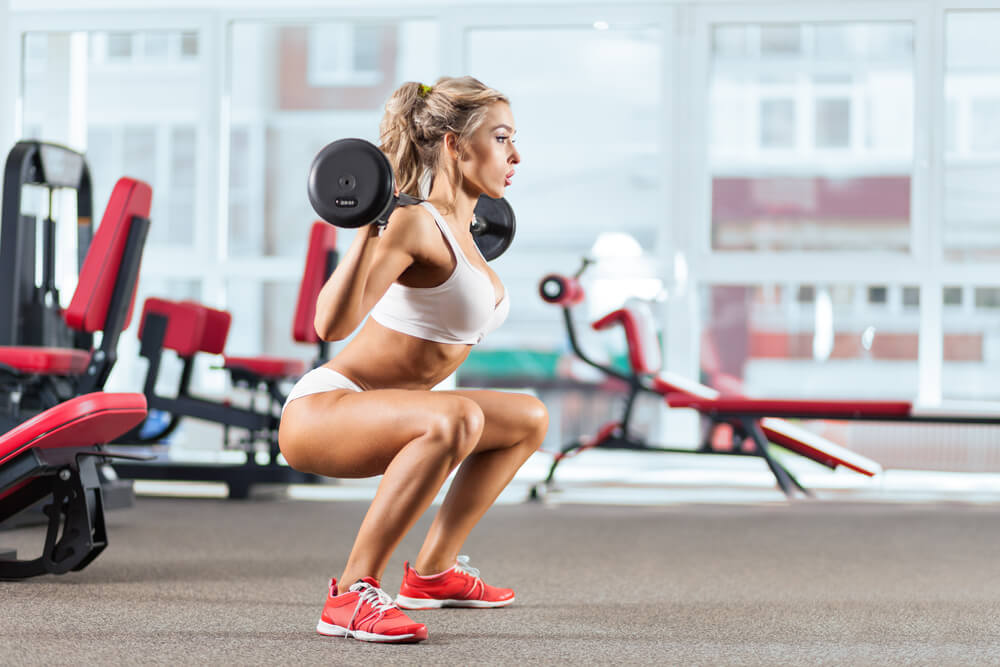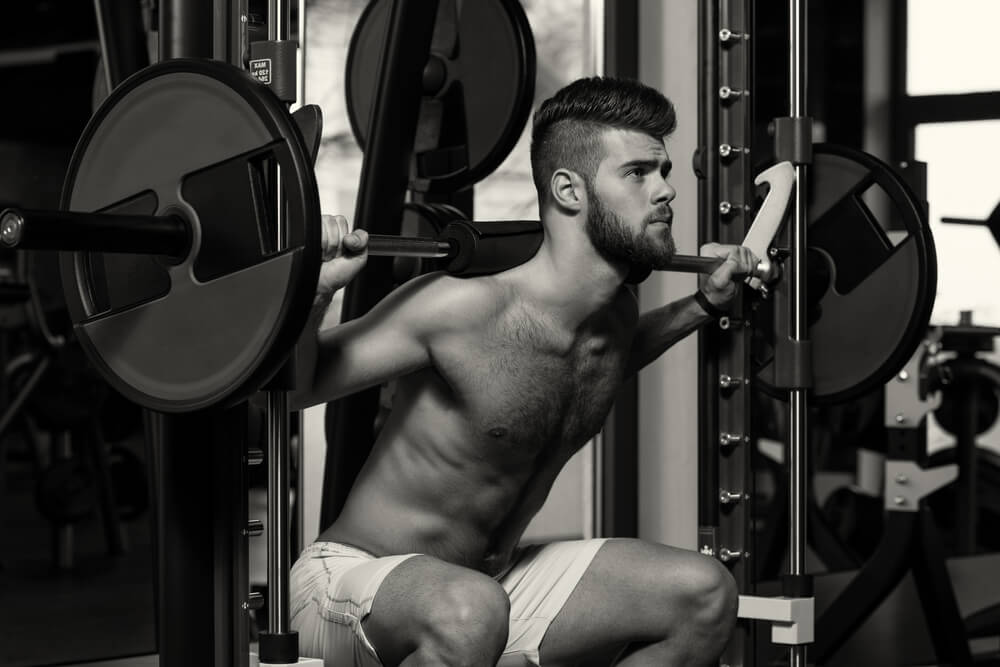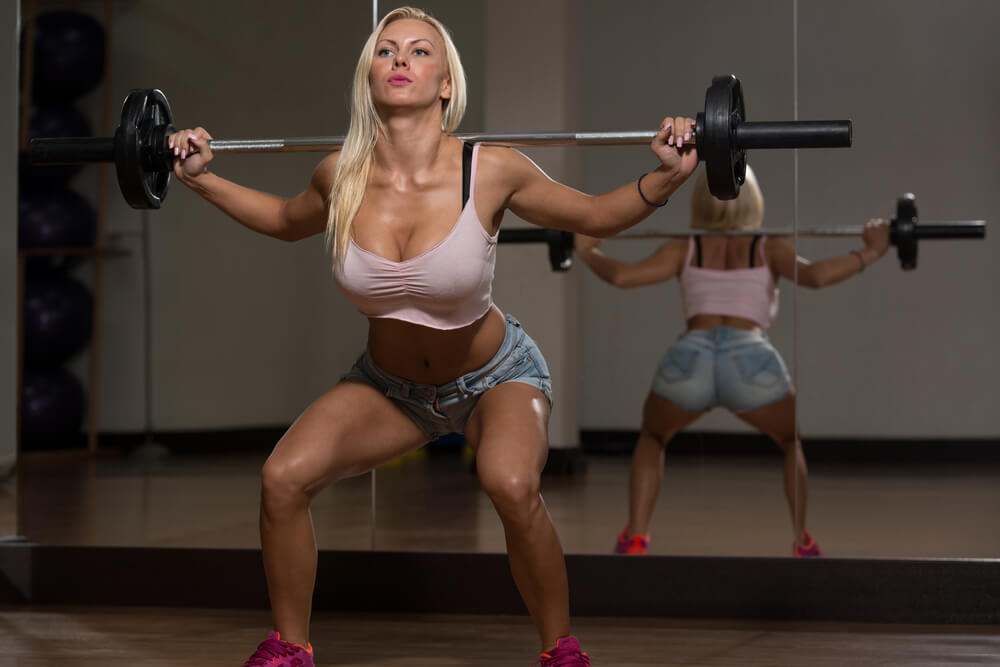
Chances are you’ve tried squats or they’re already part of your regular routine. This killer move targets 85% of your body’s muscles, but are you ready to perfect your squatting form?
Having the proper squatting form isn’t as easy as you think. When you think of squatting, you might be reminded of that gym commercial where the guy says, “I lift tings up, I put dem down.”
But squatting goes a lot more in-depth than this. In fact, some people (even gym rats) avoid squatting because if you don’t do it correctly, it can cause some serious damage. So getting the perfect squat form is a lot more important than you might realize.
Squatting requires a lot more than just being able to go up and down. You have to have excellent balance as well as hip mobility. It doesn’t stop there, however. You also need to have flexibility (and mobility) in your shoulders and even your ankles. A little bit more intense than you thought, huh?
Why is this all worth it? Simple.
Needless to say, proper squat technique is something you will want to get down 100%, because it’s incredibly successful when it comes to gaining strength and building muscle. It targets your entire lower body, as well as your core, abs and shoulders. However, the only way to make sure you’re getting the best results possible is by doing it correctly. If you do it incorrectly, or just do half-squats, you aren’t going to get the results you’re looking for. In fact, you’re dramatically increasing the likelihood of an injury.
And sure, the gym rats will sometimes scoff when they see someone doing a squat incorrectly, but here’s the thing they might not know – some people just don’t have the flexibility and mobility required to do the squat correctly. So let’s work on that.
Perfecting Your Squat Form: Where to Start and Why
What it comes down to is this – learning the proper form to do a squat is going to hard, no matter what type of condition or health you’re in. The longer that a person has been going half reps, the harder it’s going to be for them to get to the proper form. Why? Because continually training a certain muscle within a limited range of motion is going to cut down on flexibility.
But squats have some seriously amazing benefits that you’ll want. First of all, full squats are going to give you bigger, stronger legs. Because they produce a lot more muscle development in your lower body (especially the glutes, quads and hamstrings) you’re going to see some major growth in these areas.
Secondly, full squats help increase your vertical jump. A lot of athletes turn to both full and back squats in order to make an easier transfer to vertical jumps rather than partial squats. There are numerous studies that show this to be effective.
And, if you’re looking for a more athletic body overall, squats are the way to do it. They help you build amazing structural balance because it trains the muscles in the lower back and core. Added bonus – you’re going to have even better posture.
The secondary muscles worked during squats can help carve out a more toned core and will without a doubt improve balance for other movements. Making core workouts a priority will also reflect back on your squat strength.
When you do full barbell squats, you might be concerned that you’re hurting bones or your spine. But it’s actually quite the opposite. Rather, this loads the spine and has actually be shown to increase bone mineral density. So that means you’re going to be protected against things like fractures and even osteoporosis.
And, because squats are lighter than partials, it’s going to strengthen the bones and even protect your lower back. You’re also going to be building up healthy knees because any type of deep squatting is going to strengthen connective tissue, which is known to “wrap” around the knee to protect it.
Weighted squats should be part of every Perfect Leg Workout, but you can add bodyweight squats many times per week.
And, even though we’re going to address how to get better flexibility, squats themselves actually help you get there. Because you need a decent amount of flexibility, mobility and even athleticism to do a proper squat, you’re going to be improving all over your body – not just one specific area or exercise.
Why is Proper Form for Squats Important?
So we’re going to discuss how to do a proper squat, with the correct form – you want to make sure you’re getting everything you can out of the workout, and cut down on your risk of injury. Plus, you want the results to be effective, not make your workouts worse or cause injury to yourself, which will set you back weeks. We’ll also discuss how using hip/ankle flexibility and mobility workouts can help you shape your squatting.
Flexibility and mobility are the two keys you need to land before you start squatting. If not, you’re just wasting your time and making yourself vulnerable to all kinds of potential injuries. So listen up and get ready to add some new exercises to your routine.
The two forms we’re talking about today are the full squat and the parallel squat. There are other variations to the exercise, like the front squat and dumbbell squats, but we’ll get to those. First we start with the backbones of squats and proper technique.
A parallel squat is going to have your legs reaching to the parallel (aka the ground), going as deep as they can. Because this requires a pretty good amount of both ankle and hip flexibility, you’ll want to make sure you’ve got those two covered.
On the other hand, the full squat has the legs breaking the parallel plane, with the person’s butt coming within a mere couple of inches of the floor for each and every rep. Obviously, in order to do the full squat properly, you need to have a lot of hip and ankle flexibility.
You should always be able to comfortably perform squats, as well as sit in this position comfortably, before adding weights.
If you’re new to the gym, it’s a good idea to start with a beginner’s workout program to build a solid foundation. Another piece of advice that you’ll often hear us give is that you can build a strength foundation from the comfort of home if you’re not quite ready for the gym. At-home workouts and simple bodyweight workouts can be excellent first steps.
So before we dive right into the logistics behind mobility and flexibility, we want to address one question you’re probably thinking – Of those two choices for squats, which is the best to go with?
When it comes to working your muscles, the deeper you’re able to go, the more successful the squat is going to be. To put it shortly, the full squat is the best way to build up muscle, if your body is ready for that range of motion.
With that being said, the full squat is going to be a lot harder to do correctly, because of the total amount of flexibility it needs in order to be successful (and correct). Though every single person would benefit from having the full squat mixed into their current routine, you might want to go with the parallel squat first. Make sure you’re able to master this first and make the full squat your end goal.
The Role of Flexibility in Your Perfect Squat Form
We keep saying that hip mobility and flexibility are two keys to nailing squatting down. If you aren’t very flexible in the hips, it’s going to prevent you from doing a squat properly – and this is something a lot of people suffer with because of hip flexion.
This is little just a fancy word for a decrease of the angle found between the pelvis and the thighs. So as you are rising your knees, hip flexion is going to happen. There are actually numerous muscles that have a hand in this action, so if they aren’t flexible enough, you aren’t going to be able to squat in the proper form.
Luckily, there are some pretty basic stretching exercises you can do in order to help with the mobility and flexibility in the hip. One of the best stretches you can do to cut down on your flexibility problem? The kneeling hip flexor stretch. Work each leg for 2 to 3 minutes and then go right into the psoas quad stretch. If you don’t know already, the psoas major is actually a muscle in the pelvic. It’s important because it plays a huge role when it comes top hip flexion.
This muscle can actually become too tight, making squatting properly close to impossible. But the psoas quad stretch can help. Though it might seem a bit simple, it can be pretty uncomfortable if you don’t have flexibility. You want to make sure your knee is driving right into the ground, while you lean forward in order to get a good stretch. Do this for each leg for about 2 to 3 minutes, too.
Do all the stretches we listed above at least 3 times a week, going as high as 4 times a week. You will be amazed at how quickly you see yourself getting more flexible. But we aren’t done yet. Now we need to address how to improve the mobility and flexibility in your ankles for squatting. We know it might seem a little weird – how can your ankles get more flexible than they already are? But in order to get down the proper form, this is part of the deal.
Squats and Your Ankles: What to Know
If your ankles are tight, you aren’t going to be able to drop into that bottom part of the squat. Do you know what do if you’re recovering from an ankle sprain and you want to work on your squats? Your weight needs to be mostly on your heels, with your chest facing up, and your spin somewhere in a neutral position. But this is going to be close to impossible if you’ve got tightness in your ankles.
Often times when you’re squatting, it can be pretty tempting to lift your heels off of the ground. Or, sometimes, you might want to (or even do) shift the weight to the front onto your toes, meaning you’re going to have a hard time getting your butt down to that parallel position (or lower). If either, or both, of these things happen to you while you’re doing squats, odds are, ankle tightness is likely your issue.
Luckily, there are tons of exercises you can do to cut back on this.
To improve the mobility and flexibility in your ankles, all you have to do is create a routine of stretches. Each stretch should focus on the tissues found in your calves, feet and yes, ankles.
A massage lacrosse ball is a great gateway into numerous exercises that kneed out your muscles. You can specifically apply this to the ankles by applying weight to the ball under one foot and rolling it around, slowly working the muscles in your foot and ankle.
Similarly to exercises for your hips, you want to aim to do these workouts 3 to 4 times a week. Odds are, you’re going to feel a difference sooner rather than later.
So good job! You are well on your way to improving both the flexibility and mobility in your hips and ankles. Because you’re doing this, you’re going to find it easier and easier to do squats as you go along.
Other Flexibility Building Techniques for Improving Your Squats
Another simple way to make sure you nail down the perfect squat form is to do a type of squat drill at the end of each mobility and flexibility session. This way, you will be setting yourself up for success and making the proper squat form a lot more reachable. It’s going to show you the proper form because you’re going to be doing it over and over again. Plus, it’s also going to show you how well your flexibility and mobility exercises are going.
Ball Wall Sit
Using a small exercise ball, you can use this as a sort of roller against the wall against your back. The idea is to sit comfortably down into your squat, with the ball helping you to keep your spine flat and your head up. It might feel a bit odd at first but you’ll get used to it quickly. Make sure to really sit down low into your squat before driving back up.
The Wall Squat
First, you can start with a wall squat. It’s a good way to get started with the squat form drill, but it’s still gives you a challenge. Here’s how it works:
Facing a wall about a foot away from you, put your feet shoulder width apart and turn them out slightly. Put your arms above your head, with your palms again the wall. Your arms should be parallel with one another here. Then, push your hips back and slowly lower yourself into either a full squat position or just as low as you’re able to go.
The key here is to keep your hands against the wall and not also not allowing your torso, head or knees touch the wall. As you’re doing this, stay focused on making sure your knees stay In line with your toes, and keep your chest up. Your spine needs to be in a fairly neutral position, so it isn’t over-arched or rounded. If your torso, knees or head does touch the wall don’t be discouraged. Just stop what you’re doing and fix your form, then hold that position.
Conclusion
Whether you’re just starting out, looking to put together the ultimate beginner’s workout or you’re an expert looking for next level leg workouts, squats are the pillar on which you’re going to build your body’s temple. Doing these simple yet effective flexibility and mobility workouts are a great way to get you on your way to better squatting. It won’t be long before you see a huge improvement in your workouts, which is going to keep you motivated and moving forward toward better results. Remember that getting started with bodyweight workouts and simply working on your squat with no weight is always the best way to develop strength and muscle memory before the added stress of weights.
Terry
Latest posts by Terry (see all)
- How Important Are Net Carbs For Building Huge Muscle? - Apr 28, 2017
- The Matt Damon Workout Explained - Apr 27, 2017
- Watercress – Benefits And The Best Way To Consume It - Apr 26, 2017














[…] https://gymjunkies.com/squats-technique/ […]